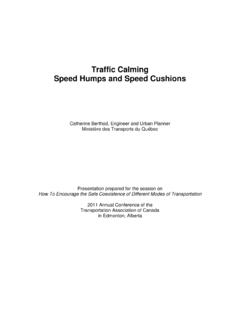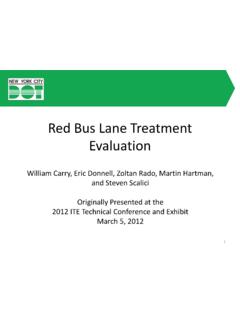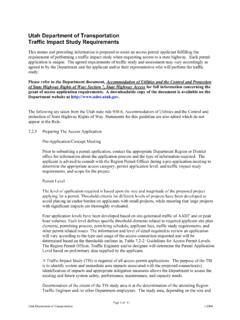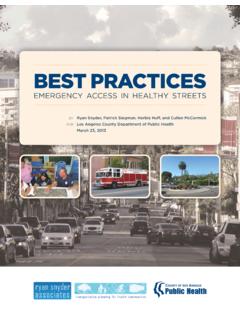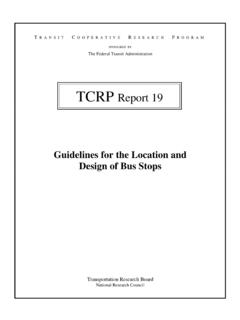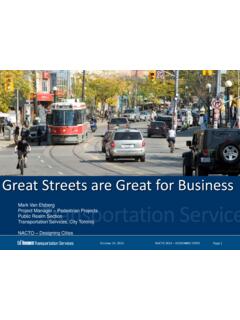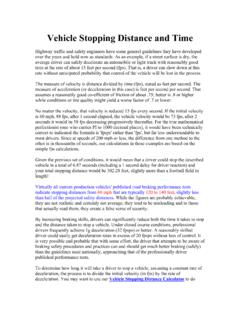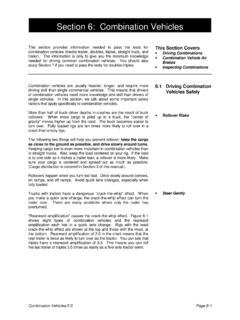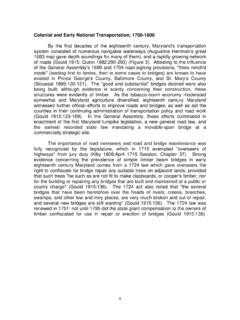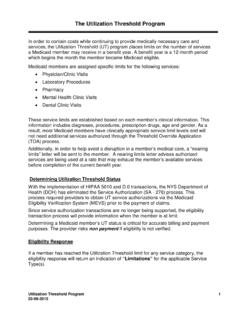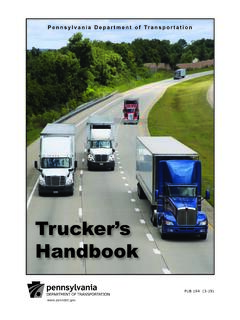Transcription of Truck Safety Considerations for Geometric Design and ...
1 1 Truck Safety Considerations for Geometric Design and Traffic Operations Eric T. Donnell, Michelle L. Adolini, Darren J. Torbic, John M. Mason, Jr., , , and Lily Elefteriadou, INTRODUCTION Truck dimensions and operating characteristics affect the physical roadway infrastructure and their impacts should be appropriately considered in the Geometric Design and traffic operations of roads and streets. Characteristics such as vehicle size and weight, sight distance, horizontal and vertical curve Design , cross-section Design , intersection Design , and traffic operational quality is critical to assess highway performance, particularly when trucks constitute a significant portion of the vehicle mix.
2 This paper summarizes recent literature useful in evaluating Truck characteristics that impact highway Design and operations. Truck DIMENSIONS AND OPERATING CHARACTERISTICS The following section describes both existing and proposed Truck dimensions, Truck acceleration and deceleration characteristics, and Truck swept path widths and turning radii. Each of these characteristics is related to the operational quality of trucks. Physical Dimensions The American Association of State Highway and Transportation Officials (AASHTO) document, A Policy on Geometric Design of Highways and Streets (herein referred to as the Greenbook), currently outlines 15 Design vehicles that are used in highway Design (1).
3 Included are one passenger car, eight trucks, two buses, and four recreational vehicles. Figure 1 shows typical Design vehicle dimensions for three of the AASHTO trucks, one passenger car, and one large bus. The vehicles shown in Figure 1 are those that are most prevalently used as the Design vehicle. Figure 1. Design Vehicle Dimensions (2). 2 The physical dimensions that most affect the minimum turning paths of Design vehicles are the minimum turning radius, the wheelbase, and the inner path of the rear tire. Trucks are wider, and have greater turning radii than do buses and passenger cars. Therefore, the Geometric Design requirements for trucks are more severe than for other Design vehicles, especially at intersections and when considering horizontal alignment.
4 Elefteriadou et al. (3) evaluated Truck combinations that have greater offtracking and swept-path widths than single 48 foot trailers. Rocky Mountain doubles, B-train doubles, turnpike doubles, triples, and larger tractor-semitrailers were considered. The evaluation considered four specific roadway Geometric elements that may not adequately accommodate large trucks (3): Horizontal curves on mainline roadways; Curb return radii for right turns at surface intersections; Curb return radii and ramp terminal right-turn radii on arterial crossroads; and, Horizontal curves on freeway on- and off-ramps. The findings suggest that there may be a substantial cost to accommodate some of these potential Truck configurations on the existing roadway network.
5 For instance, to upgrade the entire U. S. freeway and nonfreeway highway network to accommodate the baseline Truck (48-ft trailer), it would cost an estimated $653 million (3). This reconstruction would include upgrades to horizontal curves on mainline roadways to accommodate offtracking, curb return radii and right-turn roadways for at-grade intersections, curb return radii and right-turn radii for ramp terminals on the arterial crossroad at freeway-arterial interchanges, and horizontal curves on freeway on- and off-ramps. Acceleration and Deceleration Characteristics Trucks exhibit very different operating characteristics as those displayed by passenger cars when accelerating from a stopped position and on both upgrades and downgrades.
6 Both the weight/horsepower ratio and the steepness and length of vertical grades greatly influence acceleration capabilities. For high speed acceleration on level highways, trucks may display similar acceleration characteristics to those of passenger cars. Trucks can display a five percent increase in speed on downgrades and a seven percent or more decrease in speed on upgrades when compared to operations on level terrain (1). From a stopped position, trucks exhibit significantly different acceleration characteristics than those of passenger cars. Figure 2 shows Design time and distance relationships for trucks from a stopped position as per the Greenbook (1). Long (4) found that observed accelerations for WB-50 trucks are 40 to 75 percent slower than those shown in Figure 2.
7 3 Figure 2. Time-Distance Curves for Acceleration from Stopped Position (1). Truck deceleration rates are dependent upon the tire-pavement friction, pavement properties, braking efficiency, and tire properties. AASHTO policy (1) explicitly considers deceleration and braking distances for use in Design based on passenger cars, but suggests that trucks may display additional braking lengths because of their larger size and vehicle weight. Fambro et al. (5) reported that antilock braking systems provided improved stopping capability and that loaded stopping distances were significantly shorter than the empty Truck stopping distances. Harwood et al. (6) developed Truck deceleration rates for empty tractor-trailers on a wet pavement for the worst- and best-performance drivers, as well as for an antilock braking system .
8 The results of these tests are presented in Table 1. Table 1. Truck Deceleration Rates for Use in Highway Design (6). Deceleration Rate (g) Vehicle Speed (mph) AASHTO Policy (passenger cars) Worst-Performance Driver Best-Performance Driver Antilock Braking system 20 30 40 50
9 60 70 1 mph = km/h The values in Table 1 are based on an assumed driver control efficiency of (conservative, worst case scenario) and a driver control efficiency of (best-case 4 performance scenario). The antilock braking system is shown to have very similar deceleration rates as that for passenger cars. Swept-Path Widths Larger turning vehicles exhibit offtracking characteristics.
10 Offtracking is a function of a Truck s spacing between tire axles. The maximum distance between a Truck s front (lead) axle and its rear (trailer) axle determines offtracking. It is measured from the center of the rear trailer axle with respect to the center of the lead axle. Offtracking can occur in low-speed operating environments (intersections), or in high-speed operating environments (highway horizontal curves). Of interest in the low-speed environment are intersection curb return radii. Horizontal curve widening is of interest in the high-speed operating environment. Table 2 shows typical minimum turning radii of various Truck Design vehicles as noted in the Greenbook.


